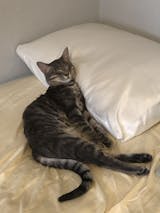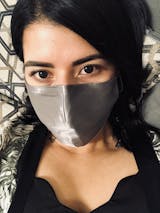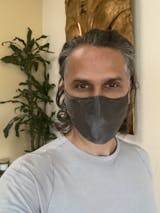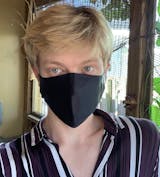At Fait avec Coeur, our mission is to create luxury, sustainable goods to elevate your everyday life. Most of our textile garments are, therefore, made from 100% organic silk. But why, you might ask, is sustainability such a focus for us, and how is silk considered a sustainable textile?
Lately, the fashion industry has been under fire for its contribution to global warming and climate change. Because of its fast-paced practices - ready to wear, seasons ahead, and transported across the seas, textile manufacturers often misuse natural resources. The industry is addressing the criticism by becoming more sustainable, a word that invites hope and heated debate at the same time.
Since fiber is the building block of fashion, nearly every effort begins with how to produce it better. So let’s dive into the sustainability of one fiber that accounts for 0.2% of the global market and contributes several billion dollars to it – silk.
Natural, luxurious, and timeless are some of the words silk-lovers use to describe the prized fabric. Its smooth and pleasing skin effects is the reason it is used in bedtime fabrics, such as nightwear, bedsheets, and of course our coveted 30 momme organic silk pillowcase.
What does sustainability even mean?
Although a subject of increased interest, there's no universally accepted definition of a fabric’s sustainability. However, the Council of Fashion Designers of America, CFDA, a not-for-profit trade association, offers a framework to help brands determine how sustainable they are. The framework covers:
- The entire lifecycle of a fabric’s production, including sourcing the raw materials, the manufacturing process, storage, transportation, and the final sale.
- The care and upkeep of the fabric, down to its repair, reuse, or recycling.
- The effects of production and usage on the environment and the community.
Where silk comes from
Silk is one of the earliest fibers in human history, evidenced by 8500-year-old Chinese tombs containing silk residue. Today, the top silk-producing countries are China who are still keeping up with their history, India, Uzbekistan, Thailand, and Brazil, the only large-scale producer outside of Asia.
Presently, more than 90% of all silk comes from the silkworm, the Bombyx mori worm. It spins a cocoon that when drawn out into a filament can be as long as a mile. The cocoon is made of a protein called sericin that protects the worm from predators and repels irritants like mold, mildew, mites, and fungi.
These excellent properties are why silk beddings provide relief for people with skin sensitivity and allergy issues. So, if allergies prevent you from enjoying a good night's sleep, an organic silk pillowcase can help. They are lightweight, breathable, and feel like a second skin.
The intricate silk production process involves:
- Mulberry cultivation - Fresh leaves from mulberry trees are food for silkworms. As such, silk producers manage mulberry farms for the best oversight.
- Rearing - In a temperature and humidity regulated indoor environment, silkworms feed on mulberry leaves for about 25-28 days. Once matured, they are moved to another setting to spin their cocoons which takes about 3 days. The cocoons are then harvested and cooked.
- Reeling - Skilled technicians combine silk filaments from multiple cocoons together using special reeling tools or machines in more mechanized farms. The reeled silk is cleaned and wound into bobbins.
- Wet processing - The silk undergoes pre-treatment for the dyeing and printing steps.
- Weaving – Hand-operated or powered looms are used to interlace the fibers into the fabric.
- Printing - The selected design is printed on the fabric (optional)
To put things into perspective, following this process, it takes one mature mulberry tree to produce enough leaves for 100 silkworms, and about 3000 cocoons to make one yard of silk fabric.
Desirable properties of silk that lend to its sustainability
Considering this intricate process, a few risks to sustainability exist. However, these risks depend on each silk producer’s individual choices to use environmentally friendly practices. And that’s one area that we at Fait avec Coeur take very seriously.
Mulberry Farms Don’t Encroach on Food Crop Land
A plus for silk production is that mulberry trees can grow on marginal land that is not reserved for food crop production, so silk does not have to negatively impact food security.
No Chemicals or Pollutants
Our silk facilities avoid the use of pesticides on mulberry trees because their presence in the leaves negatively affects the silkworms’ development as they feed. And in the rearing rooms, we opt for non-chemical methods like steaming, sun drying, or hot-air sterilization. Also, vegetable-based dyes are becoming more widespread as an alternative to azo-dyes. Fait avec Coeur works with manufactures manages their own silk farms to produce silk without using growth hormones or toxic chemicals.
Less Water Consumption
Water is essential for the cultivation, reeling, wet processing, and dyeing stages of production, however, the process of creating silk uses less water than most textile plants. Additionally, our water-conscious facilities have water treatment as an additional stage so that freshwater is conserved and treated water is recycled back into the system.
Less Energy Requirements
The only real energy use from silk production involves the cooking process to break down sericin before reeling the cocoon. Also, maintaining the rearing room at the right conditions consumes electricity. Again, the silk industry requires much less energy for production than most other textile industries. More renewable forms of energy to supplement that from coal-fired plants or fossil fuels is a step forward for conscious brands.
Supporting Rural Communities
Silk production is mostly a cottage industry in rural communities, providing a means of livelihood to about 1 million people in China, for example. Ethical facilities make sure the working conditions of all participants, on the field or in factories, are not adverse but rather improve over time with continued education and innovation.
Silk is a zero-waste fabric
All the byproducts of silk production have economic use. From the cultivation stage, mulberry fruits are nutritious to eat, wood from the trees is used for timber, foliage is used as organic fertilizer and cattle feed.
From the processing stage, lower quality silk that does not meet the standards finds its way into furniture and upholstery adornment, sericin extracted from the cocoons is used in pharmaceuticals and cosmetics, the larvae or chrysalides are human delicacies in some communities or are converted into animal feed. Silk residues are used for doll hairs and in the strings of musical instruments.
Silk is renewable
Mulberry trees and silkworms are renewable resources. The trees can be planted, and seeds can be engineered and multiplied.
Silk is biodegradable
When non-biodegradable additives such as toxic chemicals, or other fiber blends are not added, silk is 100% biodegradable. Bacteria can break the natural fibers down between 1-5 years (depending on the conditions). By contrast, synthetic fabric like polyester ends up in landfills all over the world and takes about 200 years to decompose.
(Once your 30 momme organic silk pillowcase or 100% silk face mask from Fait avec Coeur has reached the end of its useful life, you may cut it up into slivers and add it to your compost if you have one. Leave nature to do its work and those silk pieces will degrade over time.)
Sustainability is a many-spoked wheel
If sustainability can be described as a wheel, the turning of its different spokes helps it move forward. In other words, given the CFDA’s framework, silk producers may follow different approaches towards sustainability by seizing whatever opportunities they choose in the product’s lifecycle. Provided they adopt these strategies in good faith and with transparency, they contribute to the turning of the sustainability wheel. And you as a consumer will know what went into the clothes you are wearing, or the sheets you are sleeping on.
All of Fait avec Coeur's silk products are OEKO-TEX®, BSCI, and ISO certified.
References:
A.K. Prusty, Trupti Das, A. Nayak, N.B. Das, Colourimetric analysis and antimicrobial study of natural dyes and dyed silk, Journal of Cleaner Production, Volume 18, Issues 16–17, 2010.
Saviane, A., Romoli, O., Bozzato, A. et al. Intrinsic antimicrobial properties of silk spun by genetically modified silkworm strains. Transgenic Res, 2018.
Chen, Fang, et al. "Mulberry nutrient management for silk production in Hubei Province of China." Journal of Plant Nutrition and Soil Science 172.2 (2009): 245-253.
Alessandra Maria Giacomin, João Berdu Garcia, Welton Fernando Zonatti, Marcia Cristina Silva-Santos, Mariana Costa Laktim, Julia Baruque-Ramos,
Brazilian silk production: economic and sustainability aspects, Procedia Engineering, 2017.
CFDA Sustainability Index: https://cfda.com/resources/materials/detail/silk










